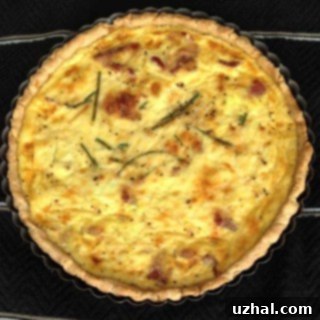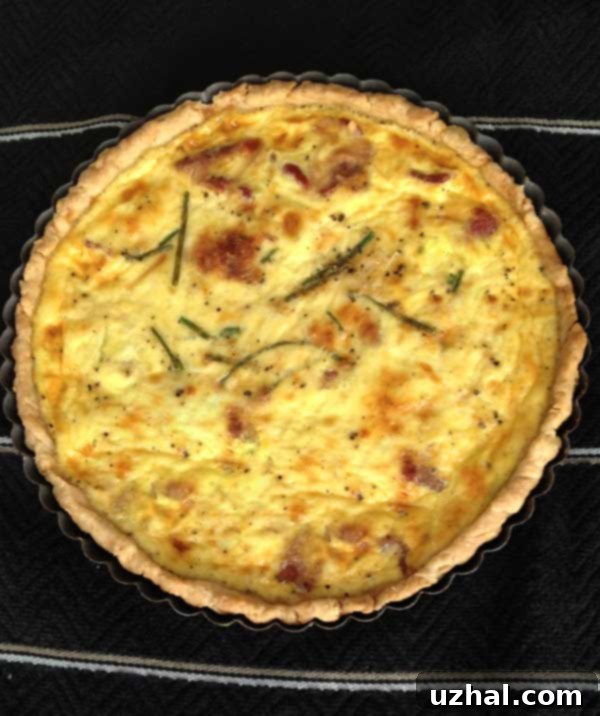The Ultimate Classic Quiche Lorraine Recipe: A Savory Delight for Any Occasion
There’s something uniquely comforting and utterly satisfying about a perfectly made Quiche Lorraine. While I adore this French classic, my enjoyment has often been a bit of a balancing act. The quest for the perfect slice often leads to a dilemma: opt for a low-fat version that tastes disappointingly like plain scrambled eggs, or succumb to the rich, decadent classic that leaves no room for dessert (a cardinal sin for many, including myself!). However, I must confess, when it comes to Quiche Lorraine, the latter — the truly indulgent, classic version — is unequivocally the best. This enduring truth was delightfully reinforced recently during a lunch visit to a charming little bakery here in Chicago. They served a Quiche Lorraine so fantastic, so utterly non-disappointing, that it was truly worth skipping dessert for (though, in fairness, they did offer a few grapes, which hardly count in my book!).
The Quest for the Perfect Homemade Quiche Lorraine Tart
That unforgettable quiche experience sparked a renewed mission: to find and perfect a truly classic Quiche Lorraine recipe that I could confidently make for various gatherings, from casual family meals to more formal parties and events. My goal was simple – a rich, creamy, and deeply flavorful quiche that stood out from the crowd. Even better, I envisioned using my trusty 9-inch tart pan with a removable bottom. This ingenious kitchen tool would allow me to effortlessly unmold the quiche, presenting it beautifully at any event without the added stress of retrieving a pie plate later. The recipe I ultimately discovered, largely inspired by the culinary genius of Emeril Lagasse, proved to be absolutely perfect!
This particular Quiche Lorraine recipe quickly became a favorite in my household. In fact, I’ve already prepared it twice in just a few days — once for my partner, Fuzz, and again for a school parent event. Both times, it was met with rave reviews and disappeared remarkably fast. If you try it and have any questions, or perhaps even a better quiche recipe you’d like to share, please don’t hesitate to email me and let me know. What I believe truly elevates this recipe above many others is the thoughtful addition of two extra egg yolks and the generous use of half-and-half. These ingredients are key to achieving that incredibly rich, custardy texture and unparalleled flavor that defines a truly exceptional Quiche Lorraine.
Why This Quiche Lorraine Recipe Stands Out
Many quiche recipes aim for a lighter profile, but often at the cost of flavor and texture. This classic Quiche Lorraine, however, embraces the richness that makes the dish legendary. The combination of whole eggs with additional egg yolks creates a custard that is exceptionally smooth, silky, and firm yet delicate. The extra yolks provide an incredible depth of flavor and a beautiful golden hue to the filling. Furthermore, using half-and-half, a blend of whole milk and light cream, ensures a luxurious creaminess without being overwhelmingly heavy. This balance allows the savory notes of the bacon and Gruyere cheese to shine through, creating a harmonious and utterly delicious experience with every bite.
The choice of a tart pan with a removable bottom is also crucial. It not only makes for a stunning presentation with its fluted edges but also simplifies the serving process. No more wrestling with slices in a deep pie dish; simply push up the bottom, and your beautiful quiche is ready to impress. This recipe combines traditional techniques with smart kitchen tools to deliver a superior result every time.
More Quiche Recipes to Explore
If you’re a fan of quiche and looking for other delicious variations, here are some other recipes you might enjoy from my collection:
- Quiche for Two or Three
- Ham, Cheddar, Gouda & Spinach Quiche
- Crustless Quiche with Ham & Broccoli
- Crustless Spinach Quiche
- Crustless Ham, Cheese & Broccoli Quiche (low fat)
Classic Quiche Lorraine Recipe

Quiche Lorraine Tart
Cookie Madness
Pin Recipe
The Perfect Flaky Quiche Crust
Ingredients
Crust:
- 1 ½ cups all-purpose flour (approx. 6.8 oz/189 grams; pastry flour can also be used for an even tenderer crust)
- ½ teaspoon salt
- ½ tablespoon sugar
- 4 tablespoons chilled unsalted butter (56 grams, cut into small cubes)
- 4 tablespoons vegetable shortening (48 grams, such as Crisco or Nutiva, chilled)
- Cold water (as needed, typically 4-6 tablespoons)
Rich & Savory Filling:
- 6 strips of thick-cut bacon (for optimal flavor and texture)
- 2 large eggs
- 2 large egg yolks (the secret to extra richness!)
- 1 ¼ cups half-and-half (approx. 10 oz, for a creamy custard)
- ¼ teaspoon salt
- ¼ teaspoon ground white or black pepper
- Pinch freshly grated nutmeg (essential for authentic Quiche Lorraine flavor)
- 1 cup shredded Gruyere cheese (shredded Swiss cheese works well too)
- Freshly cut chives or herbs de Provence (for garnish and extra aroma)
Step-by-Step Instructions for a Perfect Quiche Lorraine
Instructions
-
For the Crust: In a large mixing bowl, thoroughly stir together the all-purpose flour, salt, and sugar. Add the chilled, cubed butter and the vegetable shortening. Using a pastry blender, a fork, or your fingertips, cut the fats into the dry ingredients until the mixture resembles coarse crumbs with some pea-sized pieces of butter still visible. This is key for a flaky crust. Gradually add the cold water, 1 tablespoon at a time, gently stirring with a rubber scraper or fork after each addition. Add just enough water for the dry ingredients to become moist enough to hold together when squeezed. Avoid overworking the dough.
-
Gather the dough mixture and lightly squash it into a cohesive ball, then flatten it into a disk shape. Wrap the disk tightly in plastic wrap and chill it in the refrigerator for at least one hour, or until you are ready to use it. Chilling helps to firm up the fats, preventing the dough from becoming tough and ensuring a flaky result.
-
On a lightly floured surface, roll the chilled dough into an 11-inch circle. Carefully fit the rolled dough into a 9-inch fluted tart pan that has a removable bottom. Gently press the dough into the sides and bottom of the pan, trimming any excess. For best results, chill the prepared tart shell in the refrigerator for at least an hour, or until you are ready to pre-bake it. This second chill helps prevent shrinkage during baking.
-
To pre-bake (or blind bake) the tart shell, preheat your oven to 375°F (190°C). Line the chilled tart shell with aluminum foil or parchment paper, then fill it with pie weights, dried beans, or rice to prevent the crust from puffing up. Place the tart shell on a baking sheet and bake for 15 minutes. After 15 minutes, carefully remove the foil and weights, and continue to bake for another 10 minutes, or until the crust is lightly golden and set. This step is crucial for a crisp, non-soggy bottom. Set the baked crust aside to cool while you prepare the delicious filling.
-
For the Filling: In a skillet, cook the thick-cut bacon until it is wonderfully crisp. Drain the rendered fat (reserve it for other uses if desired) and then cut the cooked bacon into 1-inch chunks. Evenly lay these crispy bacon pieces across the bottom of your cooled, pre-baked tart shell.
-
In a large bowl, vigorously whisk together the 2 large eggs, the 2 extra large egg yolks (for that signature richness), and the half-and-half until thoroughly combined and slightly frothy. Stir in the salt, ground pepper (white or black, according to preference), and a generous pinch of freshly grated nutmeg. Finally, fold in the shredded Gruyere cheese. Pour this creamy custard mixture carefully into the prepared crust, distributing the cheese and bacon evenly. Bake in the preheated 375°F (190°C) oven until the custard is beautifully golden, puffed around the edges, and set, yet still retaining a slight wiggle in the very center when gently shaken. This usually takes about 30 to 35 minutes.
-
Once baked, remove the Quiche Lorraine from the oven and allow it to cool completely at room temperature on a wire rack. This cooling period is important for the custard to fully set. Once cooled, you can keep it chilled in the refrigerator until you are ready to serve. Enjoy it warm or at room temperature, garnished with fresh chives or a sprinkle of herbs de Provence.
Notes
Tips for a Flawless Quiche Lorraine Every Time
Achieving a bakery-quality Quiche Lorraine at home is entirely possible with a few key techniques:
- Keep Ingredients Chilled: For the flakiest crust, ensure your butter and shortening are very cold. This prevents them from fully incorporating into the flour, creating pockets of steam that result in a light, airy texture.
- Don’t Overwork the Dough: Handle the crust dough as little as possible. Overworking develops gluten, leading to a tough crust. Mix just until it comes together.
- Blind Baking is Essential: Pre-baking the crust prevents a “soggy bottom,” a common pitfall in quiche making. It ensures the crust is crisp and golden, providing a sturdy base for your rich filling.
- Quality Ingredients Matter: Use good quality bacon, fresh eggs, and a flavorful cheese like Gruyere. The better your ingredients, the more exquisite your final quiche will taste.
- Grate Your Own Cheese: Pre-shredded cheeses often contain anti-caking agents that can affect melt and texture. Freshly grating your Gruyere will give you a smoother, richer melt.
- Don’t Overbake the Custard: The key to a silky custard is to remove the quiche from the oven when it’s just set but still slightly jiggly in the very center. It will continue to cook and set as it cools. Overbaking can lead to a dry, rubbery texture.
The Storied History of Quiche Lorraine
Quiche Lorraine, despite its sophisticated French reputation, has humble beginnings. Its origins trace back to the medieval Kingdom of Lothringen (Lorraine in French), a region that has historically bordered both France and Germany. The original “Kuchen” (German for cake) or “Lorraine-Kuchen” was an open-faced pie with a filling of eggs, cream, and smoked bacon. Over time, as the region became part of France, the dish evolved into what we recognize today as Quiche Lorraine, retaining its core ingredients but often incorporating cheese. It became a popular dish across France and eventually gained international acclaim, beloved for its comforting simplicity and rich flavors. From a farmer’s meal to a gourmet delight, Quiche Lorraine has truly earned its place as a timeless culinary classic, perfect for any time of day.
Serving and Pairing Suggestions
This classic Quiche Lorraine is incredibly versatile and can be enjoyed for breakfast, brunch, lunch, or even a light dinner. Serve it warm, straight from the oven, or at room temperature. It pairs beautifully with a simple green salad dressed with a light vinaigrette to cut through the richness. For brunch, consider serving it alongside fresh fruit, mimosas, or strong coffee. At lunch or dinner, a crisp, dry white wine like a Sauvignon Blanc or a light-bodied Pinot Noir would complement its flavors wonderfully. The elegant presentation in a tart pan makes it an ideal centerpiece for any special occasion or a delightful treat for everyday indulgence.
Crafting this classic Quiche Lorraine at home is a rewarding experience that yields a truly spectacular dish. The careful selection of ingredients and adherence to traditional methods ensure a rich, creamy, and flavorful result that will impress everyone who tries it. So, don’t shy away from the richness – embrace it! You’ll find this recipe to be a worthy endeavor, proving that some classics are truly worth savoring, even if it means skipping dessert. Give it a try, and taste the difference that a few extra egg yolks and a touch of half-and-half can make!
